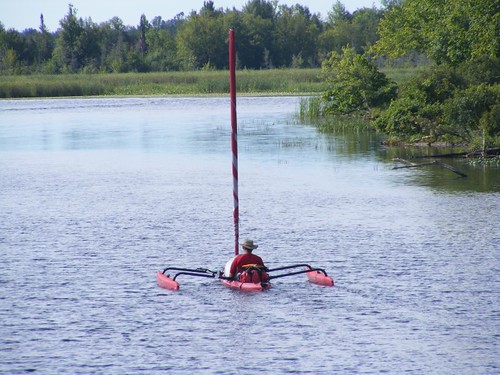August 2, 2011
Poonamalie Lock
After we pulled up the anchor at Colonel By Island, we got back out in the main canalway with our sites set on traveling 15 miles to our next stop. On the way we decided to stop at a marina, Rideau Ferry, right next to the canal for a pump-out. This facility could easily handle FLUKE, and it was easy to get to the dock. Other than almost getting hit by a powerboat that came roaring into the dock, we had success. Ordinarily we would want to take on water and fill our tanks, but we have been afraid to add any more weight. Rain has been in the forecast, but not having gotten any in about a week, added to warm, windy temperatures, the amount of water in the Rideau has been dropping. We are having more anxiety. Floating on the edge is the pits.
We planned to stop at Poonamalie because it would better stage us for where we wanted to be the following day. This lock name is so far off from the others thus far I will tell you what I found out about it. The terrain and cedars in the area reminded one of the Royal Engineers of the Tamil region in India where he had worked on a previous job. The name actually means “cat hill”. I didn't see any cats, just a rabbit, ground hog, mink, and chipmunk!
I've used the photo above to point out some more of the features of canal construction and how they affect our travel. This lock cut is VERY long; you can't even see the lock yet in the photo. It is also VERY narrow. So, when we were approaching the cut, from the lower right hand corner, there is a sign that says “Sound Your Horn”. That is so the lock people and other boaters know that you are approaching and to take heed that there may be a passing issue. The boats you see in the photo are very small ones, so don't fill the lock cut like we do. We would have been challenged to have another boat pass us, and we couldn't have given way to either side as they are rocky and narrow. Colonel By realized that this could be a problem and built a lay-by about half way up the cut, a basin where boats could pull to the side while other boats passed.
You can see a portion of the Rideau River in the photo. Notice how it has a sharp turn in it. In this area, the river is very twisting and turning, which would have made navigation difficult, so having the long cut helped.
The water control weir here is used to control the level of the water in the Lower and Big Rideau Lakes. That level affects the level in the canal and the level at the docks of all the lake owners. If it is too high, their properties could be flooded; if it is too low, the canal passage can't be maintained.
When we pulled up to the gray line at the lock at around noon, there was only one other boat present. The assistant lockmaster, Remi, came over and asked what we wanted to do. We told him that we would stay there for the night, but if other boaters came in that needed hydro we would happily move to the opposite wall and tie up since we didn't need the hydro.
In a couple of hours, 4 Montreal boats arrived, all wanting hydro. So, we asked Remi where we should go, and he pointed to the wall just across from the gray line. One of the lock attendants showed up to help with our lines. As we were nearing the wall, we felt a thud and saw that we had stirred up the bottom. We knew we had run aground, but it felt like we were on a soft material and not rock. We supplied some entertainment trying to get away from the wall and get floating again. Using the bow thruster, the boat was able to pivot off the bar and get out of there. The French people from Montreal all cheered, and one of them brought us a bottle of wine.
We decided to go through the lock and tie up on the low side (after checking the depth!). After we got settled, we tried to have a conversation with them. Fortunately a couple of them spoke English well and could translate for all of us. They suggested we consider staying in Canada until the U.S. straightens itself out! At the rate things are going, that would mean the FLUKE crew would all end up dying in Canada.
This guy set up a tent for the night at the lock. We had never seen a boat like this before; it operates by paddling with your legs or the sail can be unfurled to catch a breeze and move the boat.
So far this has been the only lock where we have had 3 different dock positions. At least we finally ended up having a peaceful night, all to ourselves in this rural area.
Saturday, August 27, 2011
Subscribe to:
Post Comments (Atom)











0 comments:
Post a Comment